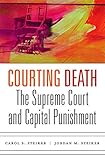Courting Death : The Supreme Court and Capital Punishment / Carol S. Steiker.
Material type: TextPublisher: Cambridge, MA : Harvard University Press, [2017]Copyright date: ©2016Description: 1 online resource (320 p.) : 1 line illustrationContent type:
TextPublisher: Cambridge, MA : Harvard University Press, [2017]Copyright date: ©2016Description: 1 online resource (320 p.) : 1 line illustrationContent type: - 9780674974852
- 345.73/0773 23
- KF9227.C2 S74 2016eb
- online - DeGruyter
| Item type | Current library | Call number | URL | Status | Notes | Barcode | |
|---|---|---|---|---|---|---|---|
 eBook
eBook
|
Biblioteca "Angelicum" Pont. Univ. S.Tommaso d'Aquino Nuvola online | online - DeGruyter (Browse shelf(Opens below)) | Online access | Not for loan (Accesso limitato) | Accesso per gli utenti autorizzati / Access for authorized users | (dgr)9780674974852 |
Browsing Biblioteca "Angelicum" Pont. Univ. S.Tommaso d'Aquino shelves, Shelving location: Nuvola online Close shelf browser (Hides shelf browser)

|

|

|

|

|

|

|
||
| online - DeGruyter Thundersticks : Firearms and the Violent Transformation of Native America / | online - DeGruyter Next Gen PhD : A Guide to Career Paths in Science / | online - DeGruyter Karl Marx : Greatness and Illusion / | online - DeGruyter Courting Death : The Supreme Court and Capital Punishment / | online - DeGruyter The Scriptural Universe of Ancient Christianity / | online - DeGruyter Sold People : Traffickers and Family Life in North China / | online - DeGruyter The Malmedy Massacre : The War Crimes Trial Controversy / |
Frontmatter -- Contents -- Introduction -- 1. Before Constitutional Regulation -- 2. The Supreme Court Steps In -- 3. The Invisibility of Race in the Constitutional Revolution -- 4. Between the Supreme Court and the States -- 5. The Failures of Regulation -- 6. An Unsustainable System? -- 7. Recurring Patterns in Constitutional Regulation -- 8. The Future of the American Death Penalty -- 9. Life after Death -- Notes -- Acknowledgments -- Index
restricted access online access with authorization star
http://purl.org/coar/access_right/c_16ec
Unique among Western democracies in refusing to eradicate the death penalty, the United States has attempted instead to reform and rationalize state death penalty practices through federal constitutional law. Courting Death traces the unusual and distinctive history of top-down judicial regulation of capital punishment under the Constitution and its unanticipated consequences for our time. In the 1960s and 1970s, in the face of widespread abolition of the death penalty around the world, provisions for capital punishment that had long fallen under the purview of the states were challenged in federal courts. The U.S. Supreme Court intervened in two landmark decisions, first by constitutionally invalidating the death penalty in Furman v. Georgia (1972) on the grounds that it was capricious and discriminatory, followed four years later by restoring it in Gregg v. Georgia (1976). Since then, by neither retaining capital punishment in unfettered form nor abolishing it outright, the Supreme Court has created a complex regulatory apparatus that has brought executions in many states to a halt, while also failing to address the problems that led the Court to intervene in the first place. While execution chambers remain active in several states, constitutional regulation has contributed to the death penalty’s new fragility. In the next decade or two, Carol Steiker and Jordan Steiker argue, the fate of the American death penalty is likely to be sealed by this failed judicial experiment. Courting Death illuminates both the promise and pitfalls of constitutional regulation of contentious social issues.
Mode of access: Internet via World Wide Web.
In English.
Description based on online resource; title from PDF title page (publisher's Web site, viewed 24. Aug 2021)


